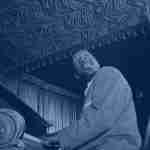The commonly known Pareto Principle states that 80% of the effects of something, come from 20% of the causes. In terms of learning, this means: figure out where the largest gains can be made and focus on those. For some reason in learning most anything, we tend to give equal weight to everything. We give equal weight to everything because we just don’t know what’s more important, so we deem everything important.
A visual that comes to mind is something I see at the gym all the time: a huge overweight guy doing fore-arm exercises. Now don’t get me wrong. It’s awesome that he’s decided he wants to make a change and he’s taken action by going to the gym. The problem is that he’s focused on something so small that he will never yield the results he so desires.
Many people have documented what they believe to be the high value exercises one should do to see maximum gains in strength and weight-loss. By researching what these are and spending the majority of his time on these things, this man could actually get to where he wants to go.
Similarly in improvisation, people work on all sorts of things that have little benefit to their skill as an improvisor. Why work harder if you can work smarter? Stop wasting your time and put all your time into the 20% of stuff that will cover the 80% of everything you’ll ever need.
Two Fives
Learning how to play over ii Vs is the most essential part of playing jazz. You can argue with that statement all you want. The longer you go without understanding ii Vs and having plenty of language to play over them, the longer you’ll feel lost in this music.
This simple progression makes up the bulk of anything you’ll ever encounter. Even when you encounter seemingly different chords, they are usually a derivative of a ii V progression.
Study this article on How to make ii Vs easy.
Get language to play over ii Vs. Every great player has done this. Once you get language over ii Vs, learn to make these lines your own. Then, keep learning more ii V language with the aim of finding new ways to play over the progression. Never stop working on them. The more free you become on them, the more free you’ll feel when you play.
Minor two fives
We encounter minor ii Vs all the time, and most people ignore or butcher them. Just like major ii Vs, minor ii Vs are in virtually every tune you’ll ever play, so what do you think, are they are part of the 20% where all this value is?
Minor ii Vs typically occur in one of two places: as a iii Vi in a iii Vi ii V progression, or as a straightforward minor ii V leading to a minor tonic. In both cases they are the same sound. Finding language to understand and play over this sound should be quite easy for you because any recording you listen to will most likely have multiple occurrences of this progression.
Just as you do with ii Vs, study what your favorite players do over minor ii Vs and get inside this harmony. Build up your own library of language on this sound and you won’t be one of the many that falls off the cliff when this progression pops up.
Blues and Rhythm changes
You’ve heard it a thousand times and still haven’t quite understood why great players always say to work on Blues and Rhythm Changes in all keys. It took me years to get a clue of why these standard forms are so vital to development as an improviser.
Any ideas about what makes these forms so crucial?
I’ll give you a hint: it has to do with the progressions we’ve already talked about. I’ll walk you through it.
If the ii V progression and the minor ii V progression are the most important progression to learn how to play over to be successful as an improviser, wouldn’t it be extremely beneficial then to practice a standard tune that utilizes these fundamental components throughout its harmony?
Blues and rhythm changes use ii Vs everywhere. If you don’t think they do, take another listen to how your heroes think about these changes instead of focusing on the lead sheet. You’ll find that they implement ii Vs anywhere they can. Forget what the changes say on a written page and understand what’s really going on. Transcribe a few choruses of your favorite soloist on a blues…then you’ll realize the gravity of working on ii Vs.
Find that 20%
Stop being that overweight guy doing fore-arm curls to lose weight. It doesn’t work. There’s a reason the push-up is a timeless exercise. It hits so many of your muscles at once and uses a significant portion of your body weight as resistance to give an entire body work out with ease.
And what do people do once they can do twenty push-ups? They do thirty. And after thirty? Forty and so on.
And what if they can do a hundred push ups and want to keep improving? They put their feet up on a ledge to increase resistance, or they start to tackle one-arm push ups, or they do a variety of endless variation to increase the difficultly.
The point is: they don’t stop doing push-ups but rather they build on what they’ve achieved by making things more challenging.
ii Vs, minor ii Vs, Blues, and Rhythm Changes are the push ups of jazz improvisation. You learn how to approach them. You learn language over them. You study them and get them in your ears.
These things make up the 20% that cause 80% of the gains. In fact, I think that these things actually make upwards of 90% of the gains. Put your time in on these simple progressions and you’ll improve way faster than your current rate. Remember, when it comes to learning anything, all topics are not created equal. Find that 20% that yields 80% of the value and go to town!










